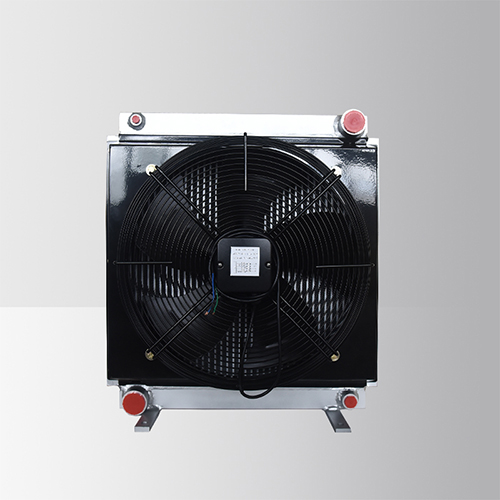For the wide range of Applications of hydraulics, high temperature cooling of hydraulic oil is the key to ensure the good operation of the equipment. We have accumulated a lot of experience in design calculation and production in the 20 years of hydraulic oil cooling. Whether the unit is a Hydraulic Oil Cooler or a hybrid hydraulic Oil Cooler, we can individually customize the product according to the individual needs of the customer's industrial hydraulic equipment. At the same time, we also offer a standard hydraulic oil cooler series solution to ensure the performance at the same time. Avoid long-term problems with separate designs, and we offer different cooling drive methods for different application areas, such as hydraulic motors, DC motors, AC motors, explosion-proof motors, pneumatic motors, etc.
Hydraulic technology is also used in solar tracking systems, wave simulation devices, ship driving simulators, seismic reconstruction, rocket-assisted launching devices, aerospace environment simulations, and high-rise building anti-vibration systems and emergency braking devices.
Industrial Hydraulics Heat Exchanger Industrial Hydraulics Heat Exchanger,Hydraulics Heat Exchanger,Hydraulic Heat Exchanger,Hydraulic Oil Heat Exchanger Xinxiang Zhenhua Radiator Co., Ltd. , https://www.thermictransfer.nl
In October of this year, the China Institute of Metrology launched the National Key Research and Development Program “National Quality Foundational Common Technology Research and Application (NQI)†key special project “Study on Key Parameters Measurement and Traceability Technology for Space Radiation Detectorsâ€. In response to the country’s policy on scientific and technological assistance for Xinjiang, and giving full play to the technical capabilities of the Xinjiang Metrology Institute, the China Institute of Metrology approved the subproject of the Xinjiang Institute of Metrology and the Institute of Ionizing Radiation Measurement and Measurement to jointly participate in this science and technology project. Research on a High Stability Activity Measurement Standard Device.
In this project, the main task of Xinjiang Metrology Institute is to develop standard measurement devices that emit alpha particles and beta particles by studying the absolute activity measurement methods for radioactive nuclide such as Am-241 and C-14, so as to form a space radiation detection value. The standard device, based on the unreliability of the magnitude of the spatial radiation detection system due to environmental conditions, studies the gain parameter stabilization technique based on a long-lived radionuclide measurement standard device. The detection system periodically measures the ray or photon signal emitted by the standard device, and based on the strength or energy of these signals, the amplifier of the detection system is automatically adjusted to change the operating voltage or amplification so that the detection efficiency or peak energy is always stable at an established level. The value thus establishes a gain auto-tuning optimization algorithm.
In order to complete this scientific and technological project in an efficient and high-quality way, the Institute of Medicine and Ionizing Radiation Measurement and Measurement of Xinjiang Institute of Metrology established a special task group, coordinated and communicated with the China Academy of Metrology Science for many times, and formulated a complete project implementation technology plan.
(Original title: Xinjiang Metrology Institute and China Institute of Metrology signed a research collaboration contract)
Because hydraulic technology has many outstanding advantages, it has been widely used from civilian to national defense, general transmission to highly accurate control systems. In the defense industry. Many of the weapons and equipment of the Air Force have adopted hydraulic transmission and control. Such as airplanes, tanks, ships, radars, artillery, missiles and rockets. In the machine tool industry, 85% of the current machine tool transmission systems use hydraulic transmission and control, such as grinding machines, milling machines, planers, broaching machines, presses, shearing machines and combination machine tools.
In the metallurgical industry, electric furnace control systems, rolling mill control systems, open hearth charging, converter control, blast furnace control, strip deviation and constant tension devices all use hydraulic technology. In construction machinery, hydraulic transmissions such as excavators, tire loaders, truck cranes, crawler bulldozers, tire cranes, self-propelled scrapers, graders and vibratory rollers are commonly used.
In agricultural machinery, hydraulic technology is also widely used, such as combine harvesters, tractors and plows. In the automotive industry, hydraulic off-road vehicles, hydraulic dump trucks, hydraulic aerial work vehicles and fire trucks all use hydraulic technology; in the textile industry, plastic injection molding machines and rubber vulcanizers are used. Paper machines, printing presses and textile machines; in the marine industry, the application of hydraulic technology is very common, such as full hydraulic dredgers, salvage boats, piling boats, oil production platforms, hydrofoil ships, hovercrafts and ship auxiliary machines. recent years.

“Radiation Detection Parameter Measurement Standard†R&D Received Help from Xinjiang Measurement Institute
[China Instrument Network Instrument R&D] Recently, Xinjiang Metrology Institute and China Institute of Metrology officially signed the “Study on Key Parameters of Spatial Radiation Detector Measurement Standards and Traceability Technology†project research collaboration contract.